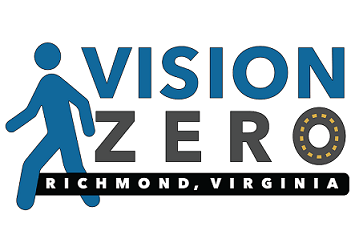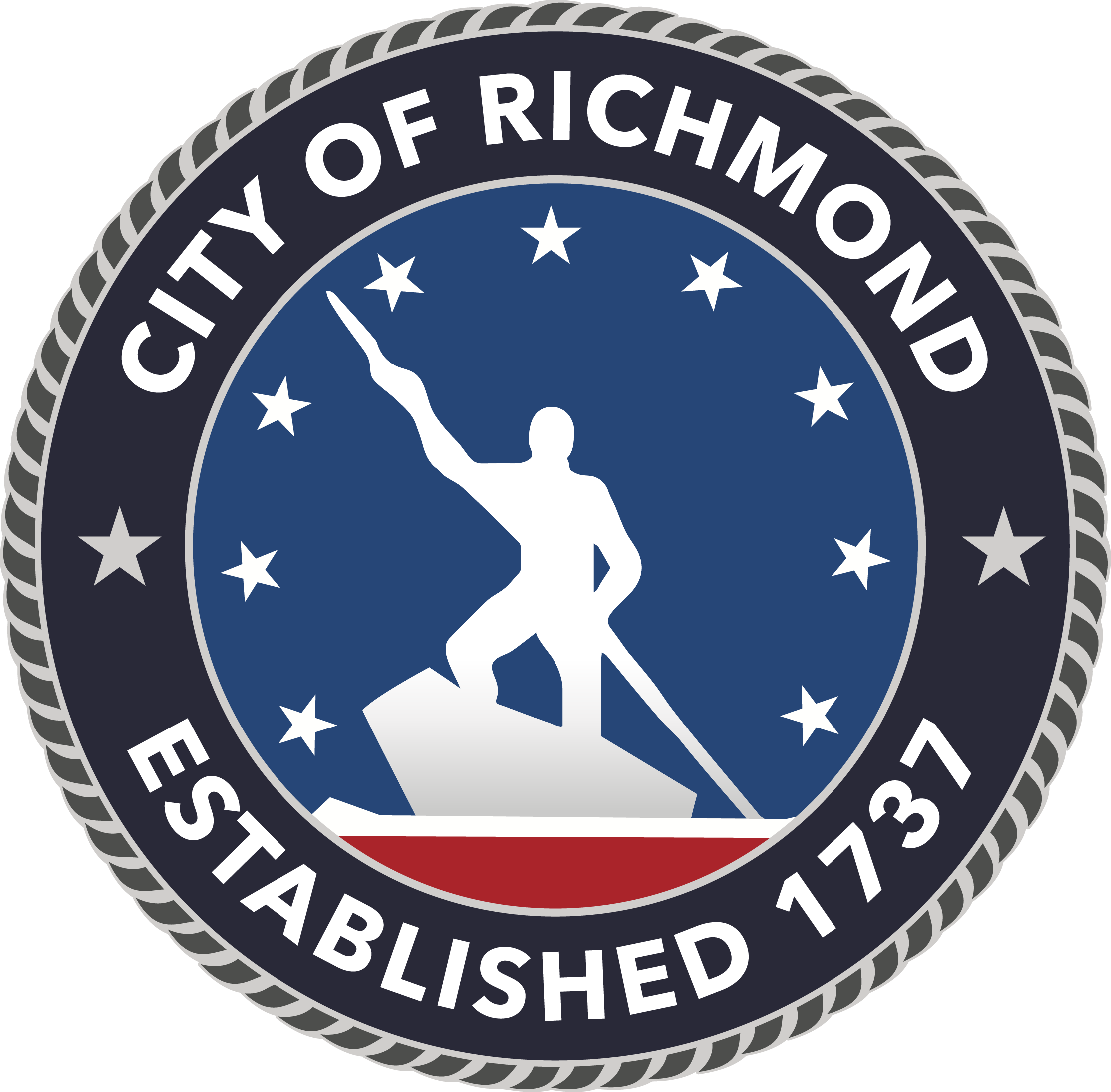
Address:
900 E. Broad Street
Richmond, VA
23219 USA
Hours: Mon - Fri (8 a.m. - 5 p.m.)
Phone No. 804-646-6430
Email: Ask Public Works
{"preview_thumbnail":"/sites/default/files/styles/video_embed_wysiwyg_preview/public/video_thumbnails/i4G20vsxKRA.jpg?itok=8G0gGm4Y","video_url":"https://www.youtube.com/watch?v=i4G20vsxKRA","settings":{"responsive":1,"width":"854","height":"480","autoplay":0},"settings_summary":["Embedded Video (Responsive)."]}
Vision Zero
Life-altering crashes are preventable. Vision Zero is a global strategy to eliminate all traffic fatalities and severe injuries while promoting safe, healthy, and equitable mobility for everyone. Originally launched in Sweden in the 1990s, Vision Zero has seen significant success across Europe and is now gaining momentum in cities throughout the U.S.
Richmond is fully committed to Vision Zero and aligns its efforts with the nine key components outlined by the Vision Zero Network. (See resources below.) The Department of Public Works leads the City's Vision Zero efforts ranging from engineering project to education campaigns. To ensure transparency and public engagement, we provide regular updates on the progress of Vision Zero. Richmonders have access to a public dashboard tracking fatality and serious injury data, prepared by the Richmond Police Department. This data empowers the community to identify safety issues and supports informed action toward safer streets.
Helpful Resources
Vision Zero Dashboard
.embed-container {position: relative; padding-bottom: 90%; height: 0; max-width: 100%;} .embed-container iframe, .embed-container object, .embed-container iframe{position: absolute; top: 0; left: 0; width: 100%; height: 100%;} small{position: absolute; z-index: 40; bottom: 0; margin-bottom: -15px;} Vision Zero DashboardSafe and Healthy Streets & Monthly Talking Points
Click to read the Safe and Healthy Streets Commission Resolution.
I will challenge myself (including my family, my school, my place of worship, and my place of employment) to do the following actions every trip to ensure that everyone arrives safely to their destination.
- Wear our seat belts
- Avoid distractions such as talking/texting on a cell phone, eating and reading while driving
- Share the road with cyclists, motorcyclists, pedestrians and large trucks
- Never drink and drive
- Obey posted speed limits
Together we can save lives and prevent injuries on our city streets.
Acepta el reto de calles seguras y saludables.
Click here to take the pledge!
Enter your name and then send us the e-mail.
These talking points are recommended for community meeting announcements, neighborhood newsletters and social media discussion groups.
January
Look out for people who walk; Be visible and put away the distractions in the crosswalk. Never assume that the person in the car sees you. People in cars should stop for pedestrians crossing the street. There is nothing protecting people who walk except our manners and our kindness. Both drivers and walkers should make eye contact and make a safe crossing work for all users.
February
Look out for people who drive unbelted. Do you know someone who doesn’t wear their seatbelt? Ask them to buckle up. You could save their life. The vehicle’s other safety devices will not protect you if you are not belted in. Ejections and partial ejections are not how our first responders want to greet you for the first time. A crash at 30 MPH is the equivalent of falling off the roof of a three story building. Buckle up. Every trip. Every time.
March
People who cross railroads. Don’t test the gates and flashing lights with your life. If you are walking next to the rails, it is trespassing; find a different route. A train is surprisingly silent as it approaches and if your ear buds are in, you will be surprised. Stop for trains. Trains can’t stop for you.
These talking points are recommended for community meeting announcements, neighborhood newsletters and social media discussion groups.
April
People who work on our roads. Our construction and maintenance crews will be in full swing this construction season. Give them plenty of room and slow down. If you see orange cones, put down your phones.
May
People who bike. May and every good weather day is Bike Month. We share the road in this City with all users. Give people who bike plenty of room. If you ride or drive, put those distractions away and be aware so you aren’t surprised.
June
People who ride motorcycles. People who drive need to be aware of people who ride motorcycles. When you scan for a gap in traffic, look closer for the motorcyclist. Share the road, and give them plenty of space. Riders, make sure you have on all your protective gear and be visible.
These talking points are recommended for community meeting announcements, neighborhood newsletters and social media discussion groups.
July
People who drive impaired. Impairment can mean drugged, drunk, drowsy, or distracted. None of these are acceptable behaviors on our city streets. Let’s watch out for each other. With improved local bus service and Uber/Lyft, there is never a reason to be impaired on our city streets. A special note regarding addiction. Addiction is a disease that if left untreated, it will destroy everything you hold dear. Please seek support so that we all can be safer on our streets.
August
People who are just learning to drive are most likely to make a poor decision leading to a crash in the first six months of driving. Parents should have more to say about when and where it is appropriate for a young driver to drive. Risk assessment is not fully developed in our brains until the age of 25. There are plenty of young drivers making mistakes. We should treat each encounter with due care and practice defensive driving by giving extra room, using our turn signals, and sharing the road.
September
People who transport children. There is no greater responsibility than the safe transport of children by walking, biking, riding, or driving. There is precious cargo on our streets every day in the form of the next generation of leaders and doers. It is state law that all occupants under the age of 18 be buckled in no matter what seat. It is also state law that special child safety seats and boosters be used until the child turns age 8. Young children are curious and impulsive; they will tend to dart out into traffic between parked cars, invisible to people who drive. As drivers, we need to be prepared to stop and travel below the posted speed limits in our city as we never can tell when our city’s youngest will run or fall into our path. Parents and guardians can also teach the rules of the road and basics of safety early through walking and biking. Our safety culture starts with our children. Our children watch their caretakers so be the example you want them to become. Keeping children safe extends past car seats. Life as a parent is full of compromises, but seat belt safety for your child is not up for negotiation. Make sure your child or teen is safely buckled up.
These talking points are recommended for community meeting announcements, neighborhood newsletters and social media discussion groups.
October
Look out for people who walk; Be visible and put away the distractions in the crosswalk. Never assume that the person in the car sees you. People in cars should stop for pedestrians crossing the street. There is nothing protecting people who walk except our manners and our kindness. Both drivers and walkers should make eye contact and make a safe crossing work for all users.
November
People who drive drowsy. Take a break. Drive Awake. Please note that two thirds of people drive drowsy. One third admit to falling asleep behind the wheel. Please get a good night sleep. Plan to drive long trips with another person. Schedule regular stops on the way to Thanksgiving Dinner and lay off the turkey.
December
People who drive impaired. Impairment can mean drugged, drunk, drowsy, or distracted. None of these are acceptable behaviors. Let’s watch out for each other. With great bus service and Uber/Lyft, there is never a reason to be impaired on our city streets. Addiction is a disease that if left untreated, it will destroy everything you hold dear. Please seek support so that we all can be safer on our streets.







